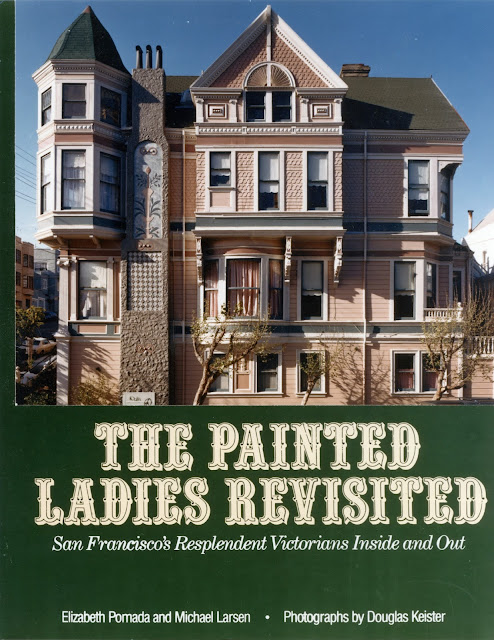 |
| Painted Ladies on Steiner Street in Alamo Square, also known as Postcard Row |
To begin, it's important to note San Francisco's role as a "unique architectural museum," write The Painted Ladies book series authors Michael Larson and Elizabeth Pomada. 48,000 Victorian houses were built here between 1850 and 1915. After the 1906 earthquake and fire, some 16,000 original houses remained; more modest and mass-produced homes were built on the western and southern sides of the city.
The colorist movement began in the “Psychedelic ‘60s” in San Francisco’s Haight Ashbury neighborhood, the heart of the counterculture of the time, Pilaroscia explains. "People wanted to show their joie de vivre and express their individuality through restoring and painting these beautifully ornamented buildings." Homeowners and professional housepainters adorned their Victorians in numerous whimsical colors, from vermillion and cobalt to gold and turquoise. Strong color was used to differentiate architectural detail and ornament typical of the period, including fanciful gingerbread trim and light-capturing bay windows. Color was used to accentuate the asymmetrical facades and detailed patterns that architects of the period used to distinguish buildings from one another.
San Franciscans were “passionate about using color to make Victorian architecture sing,” Pomada and Larson point out in How to Create Your Own Painted Lady. “By painting Victorian homes with extraordinary details in every color that hand, mind, and eye can conceive, San Francisco’s colorist movement became a unique form of self-expression.”
As the Christian Science Monitor wrote in 1987, “What started as a lark became a local then national trend." The Painted Ladies effort eventually spread to nearly every American city with similar architecture, with notable concentrations in St. Louis, Baltimore, New Orleans, and Cincinnati.
 |
| Jill Pilaroscia mixing colors in the early days of the Painted Ladies |
Pilaroscia began mixing her own colors in 1975 after graduating from the San Francisco Art Institute, joining a “boys club” of local colorists/painters.“I had to be able to do everything they did,” she remembers, including mixing paint in the back of her truck and climbing scaffolding to apply it.
 |
| Pilaroscia's color scheme for 700 Broderick uses warm terra cotta tones and features a subtle faux finish on the massive chimney. |
 |
| Pilaroscia's design for 700 Broderick Street sparkles with 23 karat patent gold leaf. |
Customizing color for these detail-rich structures was no simple task. “Victorian architecture provides many planes for color,” Pilaroscia says, “and each client wanted their house to look different.” In devising a color palette, she took cues from the house’s architecture to create a balanced, unique scheme.
The house at 700 Broderick Street in San Francisco is a case in point. For this Stick/Eastlake structure, Pilaroscia hand-mixed each color based on the house's colorful stained glass window. The overall palette grew from those hues, she says. It was a study in cool and warm. "I like working with complimentary colors as it gives a scheme complexity and dimension," she notes. "You can see more gradations that way.”
Integrating the house’s many surfaces which advance and recede as well as its ornaments is a main objective. “I like to do ribbons of color to weave the house together,” Pilaroscia explains. “It orchestrates the surfaces of a building and integrates the bay and the body.”
Pilaroscia's knowledge of color, along with her art and science practice set her up as an expert in her field. In 1987 she was recruited by Hewlett Packard's corporate real estate division to become their global color consultant for both exterior and interior environments for 14 years. Yet the legacy of Pilaroscia's role in the colorist movement lives on. As Pomada and Larsen note, “The Painted Ladies make people look up. They make people more aware and eager for color, and not just on Victorians but on all styles of architecture.”
 |
| Pilaroscia's 1919 Pierce Street color scheme painted by Local Color Painting |
Pilaroscia states, "It was a privilege to be in involved with the Painted Ladies and the colorist movement. It allowed me the opportunity to contribute to San Francisco's beloved and dynamic visual landscape."
